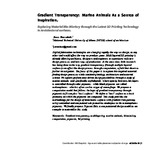Gradient Transparency: Marine Animals as a Source of Inspiration Exploring Material Bio-Mimicry through the Latest 3D Printing Technology in Architectural surfaces
| dc.contributor.author | Vamvakidis, Simos | |
| dc.date.accessioned | 2018-06-20T10:23:45Z | |
| dc.date.available | 2018-06-20T10:23:45Z | |
| dc.date.issued | 2015-09-16 | |
| dc.identifier.uri | http://hdl.handle.net/10026.1/11684 | |
| dc.description.abstract |
Digital fabrication technologies are changing rapidly the way we design, as any other tool would affect the way we produce space. Multi layered 3D printing is already allowing architects, designers and engineers to experiment with new design processes and new ways of production. At the same time, little research has being done in the way gradient transparency (through multiple layered surfaces) can affect the design process through computation; a field that deserves further investigation. The focus of this paper is to explore bio-inspired material finding design processes while combining biology, architecture and material science.We explore performance driven design possibilities through a study of marine animals -and specifically cephalopods- where opacity between skin layers is controlled through color pigments - while black pigments are called melanophores - which is often used as a type of camouflage. We propose a computation model that follows the logic of gradient transparency through pigments to fit complex "host surfaces". We define a "host" surface as a basic geometry on which the pigments are computed. This study provides the methodology for the design of biomimetic surfaces with gradient transparency, using controlled and computated sub geometries analogous to the melanophores pigments. We finally propose Pigment Skin, a computational design model as an example to materialize this study. | |
| dc.format.extent | 325-330 | |
| dc.language.iso | en | |
| dc.subject | 3D printing | |
| dc.subject | Biomimicry | |
| dc.subject | Gradient transparency | |
| dc.subject | Marine animals | |
| dc.subject | Multilayering | |
| dc.title | Gradient Transparency: Marine Animals as a Source of Inspiration Exploring Material Bio-Mimicry through the Latest 3D Printing Technology in Architectural surfaces | |
| dc.type | conference | |
| plymouth.author-url | https://www.webofscience.com/api/gateway?GWVersion=2&SrcApp=PARTNER_APP&SrcAuth=LinksAMR&KeyUT=WOS:000372316000038&DestLinkType=FullRecord&DestApp=ALL_WOS&UsrCustomerID=11bb513d99f797142bcfeffcc58ea008 | |
| plymouth.date-start | 2015-09-16 | |
| plymouth.date-finish | 2015-09-16 | |
| plymouth.publisher-url | http://ecaade.org/downloads/eCAADe-2015-volume-2-lowres.pdf | |
| plymouth.conference-name | 33rd International Conference on Education and Research in Computer Aided Architectural Design in Europe, Vienna, Austria, 16-18th September 2015 | |
| plymouth.publication-status | Published | |
| plymouth.journal | ECAADE 2015: REAL TIME - EXTENDING THE REACH OF COMPUTATION, VOL 2 | |
| plymouth.organisational-group | /Plymouth | |
| plymouth.organisational-group | /Plymouth/Faculty of Arts, Humanities and Business | |
| plymouth.organisational-group | /Plymouth/Faculty of Arts, Humanities and Business/School of Art, Design and Architecture | |
| dcterms.dateAccepted | 2015-01-01 | |
| dc.rights.embargoperiod | No embargo | |
| rioxxterms.licenseref.uri | http://www.rioxx.net/licenses/all-rights-reserved | |
| rioxxterms.type | Conference Paper/Proceeding/Abstract |


